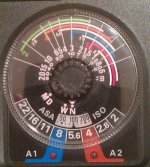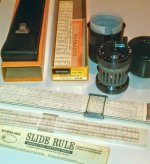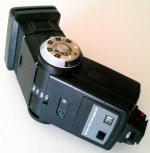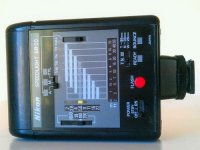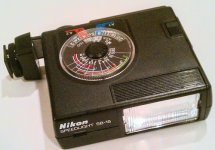seany65
Well-known
Hello all, I'd like to ask a couple of questions (I know you're all thinking "I bet he asks more questions in this thread later", and well, I probably will  ), anyway:
), anyway:
1) Can anyone recommend a good Book about using Flashguns that was written in the 1980's/early 90's? Mainly 'cos my cameras are all manual focus analogues and books later than that may be mostly about using Flashguns with digital or film cameras with 3d metering and all that stuff. I've read the Focal Guide to Flash, but too much was about flashbulbs and it didn't give much info that I could use.
2) When using one of the coloured Automatic settings of a flash, there is usually a line of the same colour starting at a near distance and going out to a distance further away and at the far end of this line there is indicated an f No. Is that the only number I should be using at that auto setting no matter where along the distance scale the thing being photographed is? eg. The distances along the coloured line goes from 5 feet to 42 feet, with f4 at 42 feet, but the subject is at 15 feet with an f No. of f16 that is either directly above or below it or is very close to the distance. Do I use f4 or f16?
Thanks for any help anyone can provide.
1) Can anyone recommend a good Book about using Flashguns that was written in the 1980's/early 90's? Mainly 'cos my cameras are all manual focus analogues and books later than that may be mostly about using Flashguns with digital or film cameras with 3d metering and all that stuff. I've read the Focal Guide to Flash, but too much was about flashbulbs and it didn't give much info that I could use.
2) When using one of the coloured Automatic settings of a flash, there is usually a line of the same colour starting at a near distance and going out to a distance further away and at the far end of this line there is indicated an f No. Is that the only number I should be using at that auto setting no matter where along the distance scale the thing being photographed is? eg. The distances along the coloured line goes from 5 feet to 42 feet, with f4 at 42 feet, but the subject is at 15 feet with an f No. of f16 that is either directly above or below it or is very close to the distance. Do I use f4 or f16?
Thanks for any help anyone can provide.
Phil_F_NM
Camera hacker
Understanding the inverse square law and the flash Guide Number (GN) system, as well as the guide number of your particular flash will make it all clear.
Phil Forrest
Phil Forrest
Bill Clark
Veteran
Google search: flash photography
Use a digital camera and experiment. You can see your results immediately.
What type of flash photography are you interested in?
This gentleman was my coach and teacher. Look at the photographs he made. Does this interest you?
https://www.pinterest.com/aefreedman/monte-zucker/
A few of them I was there to learn by helping him.
What are you asking for in #2?
When working my flash I run my camera in manual mode.
Using a digital camera is the only way to learn. You see right away what you’re learning.
Smiles.
Use a digital camera and experiment. You can see your results immediately.
What type of flash photography are you interested in?
This gentleman was my coach and teacher. Look at the photographs he made. Does this interest you?
https://www.pinterest.com/aefreedman/monte-zucker/
A few of them I was there to learn by helping him.
What are you asking for in #2?
When working my flash I run my camera in manual mode.
Using a digital camera is the only way to learn. You see right away what you’re learning.
Smiles.
Pál_K
Cameras. I has it.
Here is a rather thorough guide to understanding flash:
https://scantips.com/lights/flashbasics.html
As for your second question, I've not seen two f numbers associated with a colored line. However, usually any given f number covers a range of distance. For example, in the photo below of an SB-15, f/4 covers from roughly 20 feet to 4 feet as you look at that curved orange line (that distance range, of course, is based on all the other settings I've dialed in).
It's very likely you can find an online manual or descriptive guide for your flash. I've had no problems doing so for many flash units.
https://scantips.com/lights/flashbasics.html
As for your second question, I've not seen two f numbers associated with a colored line. However, usually any given f number covers a range of distance. For example, in the photo below of an SB-15, f/4 covers from roughly 20 feet to 4 feet as you look at that curved orange line (that distance range, of course, is based on all the other settings I've dialed in).
It's very likely you can find an online manual or descriptive guide for your flash. I've had no problems doing so for many flash units.
Attachments
Bob Michaels
nobody special
Understanding the inverse square law and the flash Guide Number (GN) system, as well as the guide number of your particular flash will make it all clear.
Phil: while I am in total agreement with you, we must acknowledge that is as unlikely as teaching people to do multiplication and division with a slide rule.
farlymac
PF McFarland
A quick search on eBay turned up 1,149 instruction manuals. I'm sure your unit could be among them.
https://www.ebay.com/sch/i.html?_fr...313&_nkw=Flash+instruction+manuals&_sacat=625
Kodak put out many books on photography, you should look for those too.
PF
https://www.ebay.com/sch/i.html?_fr...313&_nkw=Flash+instruction+manuals&_sacat=625
Kodak put out many books on photography, you should look for those too.
PF
charjohncarter
Veteran
I only use old flashes and I always check their auto and GN settings by using them on a digital camera that has some sort of manual settings. That way you get reasonable feed back quickly. Use a Wein Safe Synch just to be sure on your hot shoe or in-between your PC outlet and the flash.
It is easy, when you get your f stops zeroed in it is so rewarding.
It is easy, when you get your f stops zeroed in it is so rewarding.
Pál_K
Cameras. I has it.
... we must acknowledge that is as unlikely as teaching people to do multiplication and division with a slide rule.
As a dinosaur, I come from a time when we all did this; it is simply what we had (I used the $1 Sterling slide rule throughout my college years; the other goodies are much more recent).
Anyway, the calculator dial on the old flashes can be used to produce good results.
For those interested, the link I provided earlier is both easy reading and comprehensive.
Attachments
David Hughes
David Hughes
Hmmmm, it is very interesting and profitable to link slide rules, Fechner's Law and "or offer" on ebay, f'instance...
OTOH, the less people who know the better, imo.
Regards, David
OTOH, the less people who know the better, imo.
Regards, David
Dayrell bishop
Well-known
If you are using an auto flash use the f no for that coloured line . As long as the distance to the subject is within the stated distance of that setting ,the flash will give the right amount of light . It works by the light reflecting back to the receiver on the flash which cuts the flash when the right exposure is reached. You will have choices of different settings but just use the advised f stop for that setting .
Pál_K
Cameras. I has it.
...
It is easy, when you get your f stops zeroed in it is so rewarding.
That is so true.
For the first 50 years of my photographic life I never used flash, preferring available light. Tri-X, f/2, 1/15th. If it's dark, it's dark. From what I could see, flash, other than bounce flash, seemed too harsh.
Then a few years ago I missed making a truly beautiful portrait because I didn't use fill flash outdoors. It would've been trivial, as I was using a D700.
That got me interested in learning how to use flash. True to my fondness for old stuff, I use older units that don't have LCD screens and microprocessors. I like all the old dials and switches. So far, I've been using flash on my Contax IIIa and Nikon S2. The results have been rewarding. Flashbulbs and older cameras are next.
Attachments
David Hughes
David Hughes
seany65, It might be a good idea to mention the make and model of flash you are worrying about. Most of us have experience with one of two flashes but they are all a little bit different and it's not a general question with a simple answer.
Regards, David
Regards, David
seany65
Well-known
Here is a rather thorough guide to understanding flash:
https://scantips.com/lights/flashbasics.html
As for your second question, I've not seen two f numbers associated with a colored line. However, usually any given f number covers a range of distance. For example, in the photo below of an SB-15, f/4 covers from roughly 20 feet to 4 feet as you look at that curved orange line (that distance range, of course, is based on all the other settings I've dialed in).
It's very likely you can find an online manual or descriptive guide for your flash. I've had no problems doing so for many flash units.
@ Pal_K, Thank you for the link, I've just bookmarked it for later.
I may have given a slightly confusing idea of what my second question was about.
I know there is one coloured line associated with one of the auto settings (which is the same colour) and that, as in the photo you show, has one f. number at the end of it.
What I was trying to ask is:
Is the number on the end of that coloured line the only one I should use for all photos taken when the subject is within the limits of the distances on that line, eg. if using the orange auto setting on the flash in the pic, I would only be able to use the f4 that is at the end of the orange line, whether the subject is at 20 feet or 3 feet?
If so, does that mean all the green, white and red f. numbers are only for using the flash on its manual setting?
@Dayrell, thanks for the clear statement about what f. no we should use when the flash is in an auto mode.
@Bill Clark, At present I'm mostly interested in fill-in flash, with as near a natural look as possible, which I think would mean using my flash on 1/4-1/2 power in manual, but I wanted to find out about the "allowed" f. Nos. in the auto modes as this seems a useful thing to know.
I won't be buying a digital slr just to work with flash, and so I'm trying to find info about analogue flash.
Thanks to everyone for the replies.
I already have manuals for the flashes that I have, I was hoping for some books about using flash that were written in the 80's, hoping to avoid info about using digital stuff as I neither have, nor want, digital cameras.
I have "googled", and um, "youtubed"(?) for "flash photography" and "fill in flash" etc. but it's more or less all "whack the flash on the camera, switch both on, press this button to increase the flash's exposure or press that one to decrease it and your done" so isn't quite what I need.
charjohncarter
Veteran
On my flashes those lines correspond to the auto settings. On mine the green goes from 2.50 feet to 10 feet at 100 ISO (ASA). If you don't want to use 'auto' then you move to 'M' (manual). With the 'M' setting you have to use the focused feet on the lens, then find the feet on the dial, at this point you read f stop indicated for your lens' feet.
Manual seems like a lot of work but it is useful for studio or times you use a beauty ring or an umbrella, etc. I also use my Sekonic 208L (or maybe its 308L) it is also a flash meter. That way you have a shoot through umbrella and you meter the subject for the f stop.
Most to those Google sites deal with digital cameras and flashes that are integrated with the camera.
One of our RFF members has a tutorial on flash; he is Dante Stella: https://www.dantestella.com/technical/fill.html
I feel that Dante's tutorial would be great for you. It is like the other one listed here: long. But take either one slowly, do one flash type at a time; like fill flash. If you have DSLR and a SafeSynch you get immediate feed back.
Manual seems like a lot of work but it is useful for studio or times you use a beauty ring or an umbrella, etc. I also use my Sekonic 208L (or maybe its 308L) it is also a flash meter. That way you have a shoot through umbrella and you meter the subject for the f stop.
Most to those Google sites deal with digital cameras and flashes that are integrated with the camera.
One of our RFF members has a tutorial on flash; he is Dante Stella: https://www.dantestella.com/technical/fill.html
I feel that Dante's tutorial would be great for you. It is like the other one listed here: long. But take either one slowly, do one flash type at a time; like fill flash. If you have DSLR and a SafeSynch you get immediate feed back.
Phil_F_NM
Camera hacker
One thing less expensive than a DSLR but much cheaper than expending a bunch of rolls of film is to get a flash meter. An inexpensive Sekonic is something that I would not be without (nor have I ever) since I began my career as a photographer. Back in Navy photo school, we had a few weks of studio photography, specifically dealing with lighting. We had to use a flashmeter for every exposure and we were also using E-6 film in 35mm and 120, so exposures had to be spot on. If we botched a shot, we would have to reshoot on our own time, with our own film, then process ourselves (we always had to process ourselves though.) So I learned to trust the meter, then with years of work, I learned to trust my eye and experience.
Phil Forrest
Phil Forrest
seany65
Well-known
Thanks for the further replies.
@charjohncarter: Thanks for the link, I've bookmarked it for later. From what I understand of manual flash from my flash's manual, it seems rather easy to use for fill flash as it has 3 manual settings: full, 1/2 and 1/4 (although they are two stops apart - full=f11, 1/2+f5.6 and 1/4= f2.8), you slide one of these to the film speed being used and then the actual f no. to be used is given by the focused distance). With even more control because the 2nd head can be switched on separately and the mini head pointed to the sky!
I did want a Nikon sb20 as it has a lot of manual settings, but I couldn't make head or tails of the instructions, so I thought best not. lol.
@phil_F_NM: I have a Gossen variosix which has flash metering capability, but I couldn't hold the meter far enough away from the flash and aim it carefully enough and co-ordinate pressing the "Test" button and the metering button in the flash metering mode.
The ambient exposures it gives are good, but when I had a 10-degree "spot" metering head, it would only give readings that were 5 stops out, so there may be something/several things wrong with it and perhaps that's why I couldn't get a reading in flash metering mode?
@David Hughes: Sorry, I didn't see your post asking about the make/model of flash until after posting this the first time, don't ask me why, I don't know.
The two flashes I've got are Nissin 360tw and Nikon sb16b. I know the sb16b can be used in TTL mode with my f301, but What do I learn by using that mode? Apart from that, the 360tw seems a little more versatile.
@charjohncarter: Thanks for the link, I've bookmarked it for later. From what I understand of manual flash from my flash's manual, it seems rather easy to use for fill flash as it has 3 manual settings: full, 1/2 and 1/4 (although they are two stops apart - full=f11, 1/2+f5.6 and 1/4= f2.8), you slide one of these to the film speed being used and then the actual f no. to be used is given by the focused distance). With even more control because the 2nd head can be switched on separately and the mini head pointed to the sky!
I did want a Nikon sb20 as it has a lot of manual settings, but I couldn't make head or tails of the instructions, so I thought best not. lol.
@phil_F_NM: I have a Gossen variosix which has flash metering capability, but I couldn't hold the meter far enough away from the flash and aim it carefully enough and co-ordinate pressing the "Test" button and the metering button in the flash metering mode.
The ambient exposures it gives are good, but when I had a 10-degree "spot" metering head, it would only give readings that were 5 stops out, so there may be something/several things wrong with it and perhaps that's why I couldn't get a reading in flash metering mode?
@David Hughes: Sorry, I didn't see your post asking about the make/model of flash until after posting this the first time, don't ask me why, I don't know.
The two flashes I've got are Nissin 360tw and Nikon sb16b. I know the sb16b can be used in TTL mode with my f301, but What do I learn by using that mode? Apart from that, the 360tw seems a little more versatile.
Beemermark
Veteran
Too funny! I can still do addition and subtraction on a slide rule -Phil: while I am in total agreement with you, we must acknowledge that is as unlikely as teaching people to do multiplication and division with a slide rule.
seany65
Well-known
Quote:
Originally Posted by Phil_F_NM View Post
Understanding the inverse square law and the flash Guide Number (GN) system, as well as the guide number of your particular flash will make it all clear.
Guide numbers of my nissin 360tw, Main head only, at full power: 36m/120ft at 100 asa and N/35mm coverage, main head and 2nd head on at full power: Main: 26m/85ft, 2nd: 15m/49ft at 100 asa and N/35mm coverage.
guide numbers of my Nikon sb16b: full power:32m/105ft at 100 asa and N/35mm coverage.
Inverse square law: An object at 2m distance from a light source will receive X amount of light, at 4m distance it will receive a quarter amount of the light. Don't ask me about formulae etc. but that's the basic idea.
Which makes me wonder why the settings on my nissin 360tw flash and my nikon sb16b both give more power when the auto settings are at the f nos. for the shorter range.
Originally Posted by Phil_F_NM View Post
Understanding the inverse square law and the flash Guide Number (GN) system, as well as the guide number of your particular flash will make it all clear.
Phil: while I am in total agreement with you, we must acknowledge that is as unlikely as teaching people to do multiplication and division with a slide rule.
Guide numbers of my nissin 360tw, Main head only, at full power: 36m/120ft at 100 asa and N/35mm coverage, main head and 2nd head on at full power: Main: 26m/85ft, 2nd: 15m/49ft at 100 asa and N/35mm coverage.
guide numbers of my Nikon sb16b: full power:32m/105ft at 100 asa and N/35mm coverage.
Inverse square law: An object at 2m distance from a light source will receive X amount of light, at 4m distance it will receive a quarter amount of the light. Don't ask me about formulae etc. but that's the basic idea.
Which makes me wonder why the settings on my nissin 360tw flash and my nikon sb16b both give more power when the auto settings are at the f nos. for the shorter range.
Phil_F_NM
Camera hacker
The age and output of flashes can vary considerably. Even the brand has an effect. We did a test of Canon vs Nikon flash reliability and stability, and the Nikon SB-26 and SB-28 (pre DX) both wiped the floor with whatever brand new Canon we were using at the time (early 2000s), so much that a few of us squids who were shooting Canon, switched to Nikon flashes just to use full time on manual, and one guy switched systems completely. I had been a Pentax (personal camera) and Nikon (work camera) shooter, but I always thought a flash was a flash. After that, I swore allegiance to the SB-25/26 and have never looked back.
Re. your flashmeter: do you not have the capability to use a PC cord to synch it for testing? If not, grab a friend to trigger your flash while you take measurements?
Phil Forrest
Re. your flashmeter: do you not have the capability to use a PC cord to synch it for testing? If not, grab a friend to trigger your flash while you take measurements?
Phil Forrest
Bob Michaels
nobody special
The disadvantages of getting old are endless. But one of the benefits was learning to use flash by guide numbers or a flash meter where you had to be sure to do it right. Sometimes that was using multiple strobes that had to be balanced unequally. It was not until everyone had gone home and film was later processed that you found out if you got it right. No trial and error, just get it right or live with the consequences later.
Share:
-
This site uses cookies to help personalise content, tailor your experience and to keep you logged in if you register.
By continuing to use this site, you are consenting to our use of cookies.

